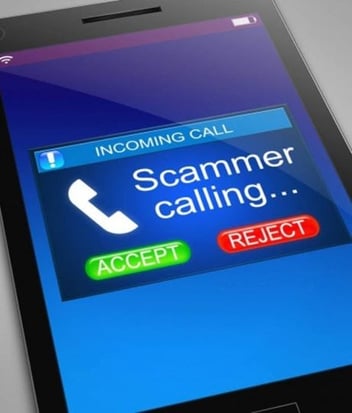Phone Fraud: 5 Red Flags to Watch Out For
Even though phone fraud isn't a new scheme, it continues to rise as a growing threat to businesses. Even though most organizations train their employees on the risks of phone fraud, malicious attackers continue to grow smarter, developing new fraud methods.
As such, it's essential to keep your employees updated on the latest phone fraud schemes and the associated red flags and how solutions like VoIP can help you avoid them.
Understanding Phone Fraud
Understanding the implications of phone fraud is crucial for businesses to protect themselves from malicious activities. Phone fraud, also known as deceptive phone practices, poses a serious threat to organizations, resulting in various negative consequences that can have long-lasting impacts.
One of the most significant consequences of falling victim to phone fraud is the financial impact. In 2022, consumers lost an estimated $8.8 billion to fraud. Considering that 36% of fraud complaints began with a phone call, phone fraud is a considerable threat–and organizations have yet to get a handle on it.
So, how does phone fraud occur? Hackers employ impersonation, social engineering, and phishing or vishing tactics to deceive employees and gain unauthorized access to sensitive information or financial resources. These attempts can result in direct financial theft or unauthorized transactions, leading to substantial monetary damages.
Beyond the immediate financial impact, phone fraud can also tarnish a business's reputation. If hackers successfully compromise customer data or engage in fraudulent activities under the guise of the business, customers may lose faith in the company's ability to protect their information. The reputational damage caused by phone fraud can have long-lasting consequences, impacting customer acquisition, retention, and overall business success.
Moreover, phone fraud can disrupt business operations. Suppose a business falls victim to a phone fraud attack. In that case, it may need to invest significant time and resources to investigate the incident, mitigate the damage, and implement enhanced security measures. This disruption can lead to productivity losses and strain the organization's resources.
Fortunately, by recognizing the implications and phone fraud, understanding red flags, and adopting a VoIP phone system, businesses can detect and respond effectively to fraudulent activities.
As such, here are the five most prominent red flags of phone fraud to look out for.
1. Unexpected or Suspicious Calls
An unexpected or suspicious call is one of the most common signs of a fraudulent phone call. These calls often catch individuals and businesses off guard as they come from unknown numbers or display suspicious caller IDs.
They may involve scammers attempting to obtain sensitive information or trick individuals into participating in fraudulent schemes. These calls often employ tactics like impersonation, urgent requests, or offers that seem too good to be true.
The best way to mitigate this attempt is by only answering calls from known numbers, but that's not always feasible for businesses. Fortunately, Simplicity VoIP offers advanced call filtering and screening features, helping companies to identify and block suspicious calls.
Additionally, Simplicity VoIP incorporates the industry-standard STIR/SHAKEN framework to combat caller ID spoofing. By leveraging STIR/SHAKEN protocols, businesses using Simplicity VoIP can enhance call authentication, verify caller identities, and mitigate the risks associated with fraudulent activities related to caller ID spoofing.
2. Unusual Call Patterns or Activity
Another critical red flag regarding phone fraud is the presence of unusual call patterns or activity. This red flag involves detecting abnormal call behaviors that deviate from the typical usage patterns of a business or individual.
Unusual call patterns may include a sudden increase in call volume, an excessive number of outgoing international calls, or a high frequency of calls made during non-business hours. These patterns can indicate unauthorized access to phone systems or the presence of fraudulent activities, such as toll fraud or call pumping schemes.
Simplicity VoIP offers valuable assistance in detecting and addressing unusual call patterns or activity. Through their call analytics and reporting tools, businesses can gain insights into call usage, including patterns, trends, and anomalies. These analytics allows for proactive monitoring and the ability to detect potential fraud attempts promptly. With Simplicity VoIP's robust features, businesses can analyze call data, set up real-time alerts for unusual patterns, and take immediate action to protect their communication systems.
3. Unsolicited Requests for Personal or Financial Information
A significant red flag for phone fraud is receiving unsolicited requests for personal or financial information. These requests typically come from unknown callers or individuals posing as legitimate entities, aiming to deceive and extract sensitive data for fraudulent purposes.
It's crucial to be cautious when confronted with unsolicited requests for personal or financial information over the phone. Legitimate organizations and financial institutions rarely make unsolicited calls to ask for sensitive data such as social security numbers, credit card details, or passwords. Fraudsters often employ tactics such as urgency, threats, or promises of rewards to manipulate individuals into divulging their confidential information.
With Simplicity VoIP's call monitoring, call filtering, and screening features, businesses can block calls from known fraudulent numbers or create call rules to identify and flag suspicious requests. This helps minimize the risk of falling victim to phone fraud schemes involving unsolicited requests for personal or financial information.
Simplicity VoIP also offers call recording capabilities, allowing businesses to maintain evidence of suspicious calls. This evidence can be valuable in identifying patterns, analyzing call content, and providing documentation if fraudulent activities need to be reported or investigated.
4. Poor Call Quality of Voice Distortion
A significant red flag to be aware of in phone fraud is encountering poor call quality or voice distortion during conversations. While occasional technical issues can occur, consistent problems with call quality or voice distortion may indicate potential fraudulent activities.
Fraudsters may intentionally degrade call quality or distort their voices to create a sense of urgency or confusion during the conversation. Doing so can make it difficult for individuals to recognize the fraudulent nature of the call and increase the likelihood of falling victim to their schemes.
In the case of international calls, factors like long-distance routing, different network infrastructures, and latency can contribute to call quality issues and voice distortion. Fraudsters may exploit these challenges to mask their true identity or location, making it harder to trace or identify their activities.
Simplicity VoIP offers reliable and high-quality VoIP services to help businesses avoid encountering poor call quality or voice distortion. Their advanced network infrastructure and robust call-routing mechanisms ensure crystal-clear voice communications. By partnering with Simplicity VoIP, companies can benefit from stable and secure call connections, minimizing the risk of encountering fraudulent activities that exploit poor call quality or voice distortion.
Additionally, Simplicity VoIP provides proactive network monitoring and troubleshooting capabilities. This enables businesses to quickly identify and resolve technical issues that may impact call quality or contribute to voice distortion. By maintaining consistent and reliable call quality, companies can effectively communicate with their customers and partners while reducing the chances of falling victim to phone fraud. Simplicity can also determine if calls are coming from locations known for fraudulent calling, further preventing the likelihood of phone fraud.
5. Unexpected or Unauthorized Changes to VoIP Accounts
Another red flag for phone fraud is the occurrence of unexpected or unauthorized changes to VoIP accounts. This involves any unauthorized modifications or alterations to the settings, credentials, or configurations of VoIP accounts without the knowledge or consent of the account holder.
Unexpected or unauthorized changes to VoIP accounts can indicate potential security breaches or fraudulent activities. Hackers may gain unauthorized access to VoIP systems, enabling them to manipulate account settings, divert calls, or exploit the resources for illicit purposes. These changes can result in financial losses, compromised communication channels, or the misuse of confidential information.
Fortunately, this attempt at fraud is much less likely to occur with a secure provider. With Simplicity VoIP's advanced account management tools and user permissions like Single Sign-On (SSO) and Multi-Factor Authentication (MFA), businesses can manage user authentication across multiple channels and applications, including their VoIP systems.
Users can also implement security measures such as PIN codes for international calling. By requiring a unique PIN code to authorize international calls, businesses can add an extra layer of protection to their VoIP accounts and mitigate the risk of fraudulent activities. Additionally, Simplicity makes it possible to block certain area codes known for fraudulent activities. By proactively identifying and blocking specific area codes associated with high instances of phone fraud, businesses can minimize the chances of unauthorized calls and reduce the potential financial impact of fraudulent activities.
For further security, Simplicity VoIP provides regular security updates and patches to address any vulnerabilities and ensure the integrity of VoIP software and systems. By staying up to date with the latest security measures and enhancements, businesses can maintain a secure and protected VoIP environment, minimizing the chances of unexpected or unauthorized changes to their accounts.
Safeguard Your Business Against Phone Fraud with VoIP
With a commitment to employee education, the integration of advanced security measures and encryption protocols, VoIP phone systems can offer businesses a more secure and reliable communication solution. By leveraging these technologies, companies can reduce the threat of phone fraud, ensuring the confidentiality and integrity of voice communications.
Stay informed, stay vigilant, and empower your business with secure VoIP phone systems to safeguard against the risks posed by phone fraud.









